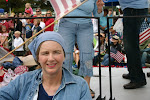Review of Felipe Smith's MBQ
Felipe Smith leads a wave of artists who are incorporating elements of American, European, and Japanese comics into a still-evolving style often called "American" or "global" manga. Smith's big break came when he was chosen for Los Angeles publisher TokyoPop's Rising Stars of Manga 3. His darkly humorous winning entry, "Manga," was inspired by a job he wasn't paid for. That led to a contract with TokyoPop to do the three-volume MBQ, one of the few original English-language manga series that TokyoPop stayed with until its conclusion.
MBQ focused on Los Angeles' South Bay region, and was inspired by real people and actual locations. It follows six major characters through a night and day of life and death. Smith says the dreadlocked artist, Omario, is autobiographical. Being character-driven, the plot is episodic, akin to a Robert Altman film or Bertolt Brecht play.
"Most stories, and manga, have one linear character. I have six," Smith explains. "They don't know each other at times, and they're from different parts of town. I need to cover all their stories at the same time because as the story progresses, their paths start to merge."
"I basically want to have an overall sense of what's going on in LA at any time," he adds. "So the reader comes away picking up on certain coincidences," hence the reason why the plotting appears so disconnected in the first volume. It's worth bearing with the developments in subsequent volumes, however.
Smith came to Los Angeles to work as an animator after attending art school in Chicago. "After a while I realized that was not what I wanted to do," he says. "I wanted to be able to do different kinds of drawings, for adults."
He counts the realistic manga Tokyo Tribes as an influence. In his efforts to bring a similar style to the screen, he found "a lot of studios told me that animation is very limited, style-wise. What I was doing was too complicated," so he moved sideways into manga.
As to why he works in manga instead of a more traditional type of comics, he explains, "I think it's the storytelling. Manga--obviously--being about 200 pages, has more time to tell the story. I have a chase scene [in MBQ, vol. 1] that's about 30 pages. [A traditional American-style comic book] comes out once a month and it's 22 pages. My chase scene is a whole story."
Smith has now found a new home in the Japanese comic scene. His follow-up to MBQ is Peepo Choo, an entirely new story about a gathering of anime fans, which was originally published in Japan. Vertical is publishing an English-language version that currently runs three volumes.


0 Comments:
Post a Comment
Subscribe to Post Comments [Atom]
<< Home